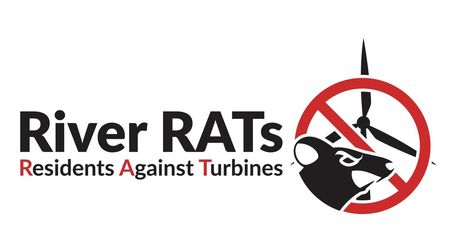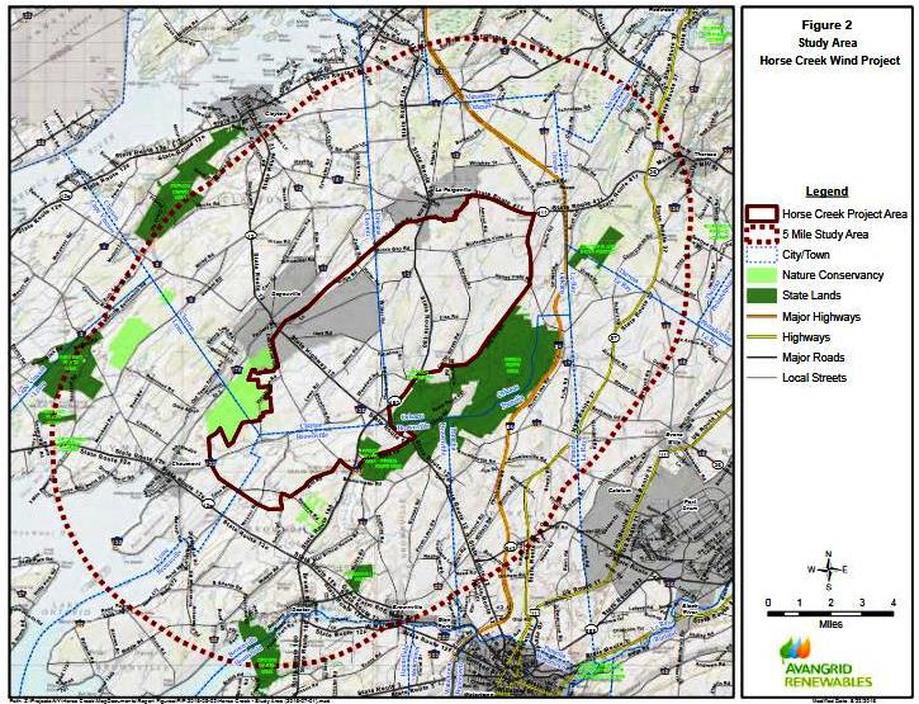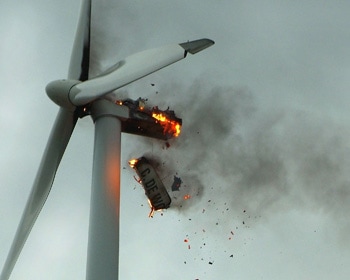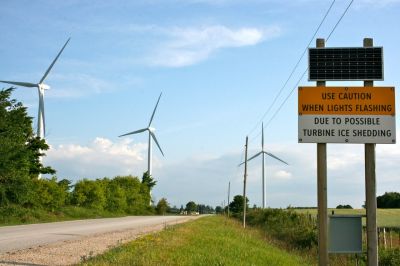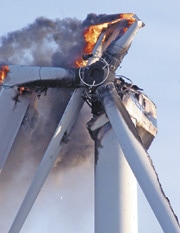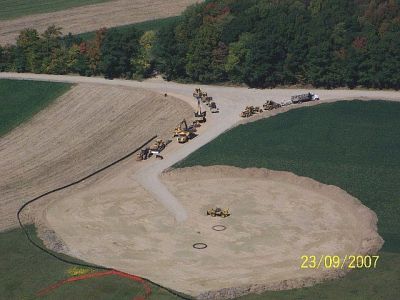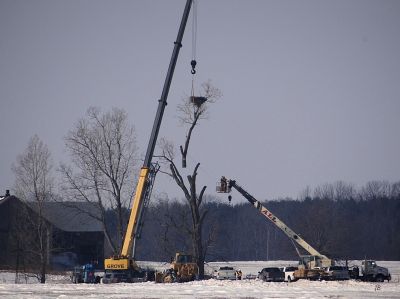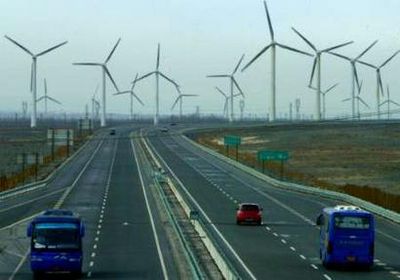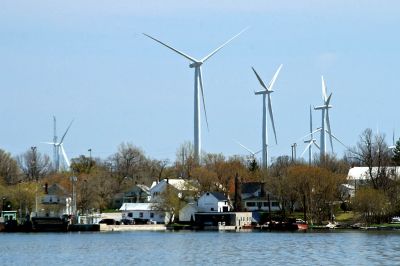Project Summary
The Horse Creek Wind Project is an industrial wind power generation facility proposed for the magnificent 1000 Islands region of New York State by the Spanish multinational corporation Iberdrola via its American subsidiaries Avangrid and Atlantic Wind LLC.
Consisting of 60-72 skyscraper-tall industrial wind turbines, new access roads and high-voltage transmission lines spread over 14,000 acres in the towns of Clayton, Orleans, Lyme, and Brownville, Horse Creek would site turbines five miles or less from the magnificent St. Lawrence River and the world- famous 1000 Islands, North America’s most beautiful archipelago. Furthermore, Horse Creek would be located less than five miles from the Watertown International Airport and eight miles from Fort Drum, two leading economic drivers of Jefferson County.
Horse Creek would destroy the beauty, culture, environment, economy, and health of this incomparably beautiful and unique region. The project is overwhelmingly opposed by a majority of residents and stakeholders, including local and county governments. Nevertheless, Iberdrola wants to transform this tourist-dependent region into an unwanted and wholly inappropriate mechanical landscape.
Consisting of 60-72 skyscraper-tall industrial wind turbines, new access roads and high-voltage transmission lines spread over 14,000 acres in the towns of Clayton, Orleans, Lyme, and Brownville, Horse Creek would site turbines five miles or less from the magnificent St. Lawrence River and the world- famous 1000 Islands, North America’s most beautiful archipelago. Furthermore, Horse Creek would be located less than five miles from the Watertown International Airport and eight miles from Fort Drum, two leading economic drivers of Jefferson County.
Horse Creek would destroy the beauty, culture, environment, economy, and health of this incomparably beautiful and unique region. The project is overwhelmingly opposed by a majority of residents and stakeholders, including local and county governments. Nevertheless, Iberdrola wants to transform this tourist-dependent region into an unwanted and wholly inappropriate mechanical landscape.
As viewed over the Horse Creek project site near Depauville at 400 feet - well below the proposed turbine height.
Project Specifics
The Horse Creek Wind Project would construct 60-72 industrial wind turbines, new access roads, and transmission lines in the 1000 Islands region of New York State, primarily in the riverfront Towns of Clayton and Orleans. Two other towns with extensive Lake Ontario shoreline, similar cultures and economics, the Towns of Brownville and Lyme, would also be sacrificed with wind turbines and high-voltage transmission lines.
Turbines could be located five miles or less from the St. Lawrence River and the Village of Clayton, recently named one of North America's best small towns and America's best hidden getaway. Turbines would ruin the viewshed of the islands, Thousand Island Park, Alexandria Bay and Boldt Castle, recently voted New York's #1 attraction by "I Love NY".
Complete with flashing lights, environmental dangers and harmful infasound vibrations, the 40-story-or-greater turbines would be sited over an area of 14,000 acres, transforming a peaceful, rural landscape into a regionally-inconsistent industrial power generation facility. The current project proposal is nearly 5,000 acres larger than the 2011 proposal, and has significantly increased from a 96 MW project consisting of 48 turbines in 2011 to the current 205 MW and 60-72 turbine proposal.
Preliminary turbine height is stated at up to 500+ feet (Higher than the Wolfe Island turbines across the St. Lawrence River in Canada that have caused tremendous problems and property devaluation). There is also no guarantee that the developer will not attempt to increase turbine height. Given the flexibility of New York's Article 10 siting approval process, turbine height could be adjusted upward by the developer during the course of the review process to 600 or 700 foot turbines reflecting current industry trends and technology.
At up to 500+ feet these structures would dwarf the 11-story Dulles State Office Building in Watertown, currently the tallest building in the region, and completely overshadow all local community buildings, homes, and farm structures.
Turbines could be located five miles or less from the St. Lawrence River and the Village of Clayton, recently named one of North America's best small towns and America's best hidden getaway. Turbines would ruin the viewshed of the islands, Thousand Island Park, Alexandria Bay and Boldt Castle, recently voted New York's #1 attraction by "I Love NY".
Complete with flashing lights, environmental dangers and harmful infasound vibrations, the 40-story-or-greater turbines would be sited over an area of 14,000 acres, transforming a peaceful, rural landscape into a regionally-inconsistent industrial power generation facility. The current project proposal is nearly 5,000 acres larger than the 2011 proposal, and has significantly increased from a 96 MW project consisting of 48 turbines in 2011 to the current 205 MW and 60-72 turbine proposal.
Preliminary turbine height is stated at up to 500+ feet (Higher than the Wolfe Island turbines across the St. Lawrence River in Canada that have caused tremendous problems and property devaluation). There is also no guarantee that the developer will not attempt to increase turbine height. Given the flexibility of New York's Article 10 siting approval process, turbine height could be adjusted upward by the developer during the course of the review process to 600 or 700 foot turbines reflecting current industry trends and technology.
At up to 500+ feet these structures would dwarf the 11-story Dulles State Office Building in Watertown, currently the tallest building in the region, and completely overshadow all local community buildings, homes, and farm structures.
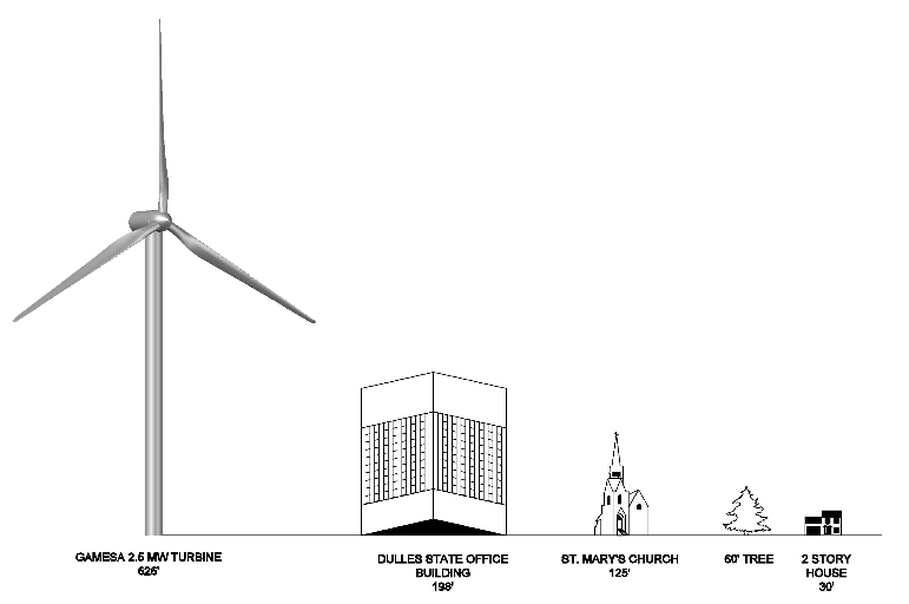 Gamesa 2.6 MW Turbines (626 ft) would fulfill Iberdrola's plans to produce 205 MW from 72 turbines (205/72=2.84 MW/Turbine)
Gamesa 2.6 MW Turbines (626 ft) would fulfill Iberdrola's plans to produce 205 MW from 72 turbines (205/72=2.84 MW/Turbine)
Project Location
Based on the limited public information presented by Iberdrola, the Horse Creek project area starts immediately south of Depauville in the Town of Clayton, and south of Lafargeville in the Town of Orleans.
Lining both sides of picturesque Route 12 between the Perch River WMA and Hamlet of Depauville, the heavily-traveled and primary highway to the waterfront Village of Clayton and the 1000 Islands, you would literally drive through a mechanical landscape of up to 72 wind turbines 40 or more stories high.
To the west, the project area stretches toward Lake Ontario about two miles from the Village of Chaumont and only three miles from the Village of Dexter. Turbines would also likely extend eastward (south of Lafargeville) almost to Interstate 81, another main artery to reach the 1000 Islands. Travelers bypassing Route 12 and proceeding directly to Alexandria Bay and Wellesley Island via Interstate 81 would also be subjected to the eastern portion of the project. A review of current public Jefferson County wind lease records, as well as information gathered by River RATs, indicates that wind leases have been signed or discussed as close as two miles from the St. Lawrence River shoreline, potentially further expanding the project area.
The project area based on Iberdrola's 2016 Revised Public Information Program
Atlantic Wind LLC / Avangrid Renewables / Iberdrola
|
Horse Creek is developed by Spanish-based, for-profit corporation Iberdrola S.A. via American subsidiaries Avangrid, Inc., Avangrid Renewables LLC and Atlantic Wind LLC.
Iberdrola is one of the world's largest energy multinationals and the largest industrial wind company in the world. It is currently developing numerous wind projects throughout Northern New York, although none as close to either Fort Drum or the 1000 Islands as Horse Creek. Iberdrola is a publicly traded company. The largest outside shareholder (2017) is the Qatar Investment Authority, which holds 9.7% of the company. In the New York and other states, Iberdrola has been the subject numerous reports concerning its business operations. In New York, Iberdrola has been sued by 60 residents living near its Hardscrabble Wind Power Project in Herkimer County due to noise, health, and property devaluation concerns. In Vermont, according to Grafton Windham Wind, a grassroots community organization that successfully defeated another Iberdrola wind project, "Iberdrola’s fraudulent and corrupt business practices are known the world over, and the company currently faces millions of dollars in fines, tens of millions in proposed fines, and a worldwide ban on World Bank financing. |
3,521
Miles between the Horse Creek Wind Project and Iberdrola's foreign ownership headquarters in Spain
6,601
Miles between the Horse Creek Wind Project and Doha, Qatar, headquarters of the Qatar Investment Authority, Iberdrola's largest outside shareholder
The Qatar Investment Authority holds 9.7% of Iberdrola S.A.
Iberdrola S.A. is based in Bilbao, Euskadi (Basque Country) Spain
|
In California, state utilities authorities recently found Iberdrola “misled state officials” and overcharged the state by $371 million during the state’s 2000-2001 energy crisis.
In Connecticut, Iberdrola/Avangrid is being investigated by the Connecticut Public Utilities Regulatory Authority, and a recent article in the New Haven Register notes Iberdrola likely changed its US business name to Avangrid because of the “baggage” associated with Iberdrola being at the center of five recent cases of bribery, fraud, and corruption across the globe.
And back in their home country of Spain, Iberdrola was recently fined $27M for market manipulation."
Again we ask - Is this the type of community and business member we want for Jefferson County and the 1000 Islands?
In Connecticut, Iberdrola/Avangrid is being investigated by the Connecticut Public Utilities Regulatory Authority, and a recent article in the New Haven Register notes Iberdrola likely changed its US business name to Avangrid because of the “baggage” associated with Iberdrola being at the center of five recent cases of bribery, fraud, and corruption across the globe.
And back in their home country of Spain, Iberdrola was recently fined $27M for market manipulation."
Again we ask - Is this the type of community and business member we want for Jefferson County and the 1000 Islands?
Explore Further
Key Project Negatives
Potential Harm to Watertown International Airport
Horse Creek's wind turbines, located less than five miles from the Watertown International Airport (WIA), pose a significant threat to not only current flight operations but also plans for future growth. WIA provides private, commercial, and military services (Fort Drum accounts for 30% of operations). WIA is an Essential Air Services community airport that supports business and tourist related passenger flights to the area.
As has been demonstrated in reports commissioned by the Department of Homeland Security, wind turbines can interfere with radar operations. Additionally, wind turbines present "vertical obstructions" to flight paths that could jeopardize future growth at WIA and impact the overall growth of Jefferson County. These concerns occur at a time when WIA is on an upswing in activity and improvements, including more than $3.5 million in federal funding that was used for the recently completed runway extension project.
Speaking about the FAA funding authorization in September 2016 U.S. Sens. Charles E. Schumer and Kirsten E. Gillibrand expressed the importance of WIA to the regional economy,
“We worked very hard to secure this funding because better service in to and out of Watertown is fundamental to growing the region’s economy and to attracting more planes and more business and more tourism to the region,” Sen. Schumer said. “With this funding, the Watertown International Airport will be able to make the critical upgrades necessary to ensure its runway and taxiway are top-notch and safe for the passengers and pilots who fly in and out of Watertown every day.”
“Watertown International Airport is a vital economic anchor in Jefferson County, and it has to meet the best standards for efficiency and safety," Sen. Gillibrand said. "Investing in our airport’s infrastructure will make it better for the businesses and travelers who rely on it every day.”
In 2016 the airport also received state recognition for its recently completed projects. The new fixed business operator and hanger were awarded the Phil Brio Project of Year Award by the New York Aviation Management Association.
Again we ask - Why put all this in jeopardy for the poorly sited Horse Creek project?
Potential Harm to Fort Drum
Located only eight miles from Fort Drum, Horse Creek endangers the military functionality and economic future of Northern New York’s largest single employer. With over 18,000 full-time military and civilian jobs, Fort Drum is also a Designated Regional Collective Training Center that provides full-spectrum training and base operations support to all the service branches and trains an additional 23,000 Reserve, National Guard and other agency personnel annually. Overall, Fort Drum is a $1.2 billion annual economic driver to the region.
As has been noted by the National Oceanic and Atmospheric Administration (NOAA), wind turbines built near military bases can interfere with important radar installations. Horse Creek would interfere with Fort Drum's Wheeler-Sack military airfield radar installations and disrupt current military air operations, including low-level helicopter and drone training. This would only add to the radar interference Wheeler-Sack already has experienced due to Iberdrola's Maple Ridge wind farm located outside Lowville in Lewis County, about 15 miles from the fort. Any additional wind-induced radar interference would also damage Fort Drum's ability to competitively compete as the location for the new East Coast Missile Defense System (Fort Drum is currently one of three sites in the final selection).
There are legislative and planning actions underway related to wind turbine radar interference:
First, increasing national concern for industrial wind turbine interference in military radar and airfield operations has resulted in pending federal legislation that will prohibit federal tax credits and subsidies for wind developers who locate within 40 miles (Sen. 201) and 30 miles (H.R 649) of a military airfield. These tax credits and monetary subsidies are the essential life-blood of industrial wind and are required to make any project economically viable. If 30 or 40 miles distance is a concern for military operations according to the proposed national legislation - how can Horse Creek be justified at only eight miles?
On the local level, the DoD, sponsored by the Development Authority of the North Country, is currently conducting a Joint Land Use Study (JLUS) for the Fort Drum area. In addition to radar interference, industrial wind turbines are considered "vertical obstructions" for military aircraft, and are compatibility factors that will be taken into consideration during the study. As such, it is likely that Horse Creek's turbines, located so close to Fort Drum, will be acknowledged by the DoD as incompatible with current and future operations.
As has been noted by the National Oceanic and Atmospheric Administration (NOAA), wind turbines built near military bases can interfere with important radar installations. Horse Creek would interfere with Fort Drum's Wheeler-Sack military airfield radar installations and disrupt current military air operations, including low-level helicopter and drone training. This would only add to the radar interference Wheeler-Sack already has experienced due to Iberdrola's Maple Ridge wind farm located outside Lowville in Lewis County, about 15 miles from the fort. Any additional wind-induced radar interference would also damage Fort Drum's ability to competitively compete as the location for the new East Coast Missile Defense System (Fort Drum is currently one of three sites in the final selection).
There are legislative and planning actions underway related to wind turbine radar interference:
First, increasing national concern for industrial wind turbine interference in military radar and airfield operations has resulted in pending federal legislation that will prohibit federal tax credits and subsidies for wind developers who locate within 40 miles (Sen. 201) and 30 miles (H.R 649) of a military airfield. These tax credits and monetary subsidies are the essential life-blood of industrial wind and are required to make any project economically viable. If 30 or 40 miles distance is a concern for military operations according to the proposed national legislation - how can Horse Creek be justified at only eight miles?
On the local level, the DoD, sponsored by the Development Authority of the North Country, is currently conducting a Joint Land Use Study (JLUS) for the Fort Drum area. In addition to radar interference, industrial wind turbines are considered "vertical obstructions" for military aircraft, and are compatibility factors that will be taken into consideration during the study. As such, it is likely that Horse Creek's turbines, located so close to Fort Drum, will be acknowledged by the DoD as incompatible with current and future operations.
Again we ask - Why put all this in jeopardy for the poorly sited Horse Creek project?
Damage to Cultural Resources Including Tribal Nations Sacred and Ceremonial Landscapes
Project construction and wind turbine lighting would affect, damage or even destroy cultural resources, including Sacred and Ceremonial Landscapes associated with the Onondaga, Oneida, and Mohawk Nations. Many of these cultural resources are found within the project area and wind turbine viewshed, including documented sites in Depauville, Perch Lake, and on Fort Drum itself. River RATs believes that the right thing to do is to suspend all project development until full, prior consultation and authorization from the Nations is completed.
Again we ask - Why put all this in jeopardy for the poorly sited Horse Creek project?
Destruction of the Regional Viewshed
The project would destroy the foundation of the region's economic model and tourism-based economy. Industrial wind turbines at Horse Creek will destroy the viewshed of the St. Lawrence River, the 1000 Islands and Golden Crescent of eastern Lake Ontario.
Given the St. Lawrence River’s sloping geography, the massive structures of the turbines and their flashing lights will create an ever-present visual nightmare. This scenario already occurs with the Wolfe Island wind complex with turbine height lower than proposed for Horse Creek. Given the poorly-sited Horse Creek location and up to 500+ feet turbine height combined with the sloping St. Lawrence River valley topography, the extensive turbine field will be visible for many miles – both day and night - including Cape Vincent, Clayton, Alexandria Bay, the islands, on the river, Watertown and Fort Drum.
The 1000 Islands depends upon world-class visual and natural resources as an economic engine. Damaging the area's unique and revenue-creating visual resources would cause the regional economy to drastically suffer and increase unemployment.
Given the St. Lawrence River’s sloping geography, the massive structures of the turbines and their flashing lights will create an ever-present visual nightmare. This scenario already occurs with the Wolfe Island wind complex with turbine height lower than proposed for Horse Creek. Given the poorly-sited Horse Creek location and up to 500+ feet turbine height combined with the sloping St. Lawrence River valley topography, the extensive turbine field will be visible for many miles – both day and night - including Cape Vincent, Clayton, Alexandria Bay, the islands, on the river, Watertown and Fort Drum.
The 1000 Islands depends upon world-class visual and natural resources as an economic engine. Damaging the area's unique and revenue-creating visual resources would cause the regional economy to drastically suffer and increase unemployment.
Looking at the image above, imagine 72 much taller and brighter turbines, visible almost everywhere throughout the 1000 Islands region, including on the St. Lawrence River. This extreme visual transformation is the new reality if Horse Creek is constructed.
Again we ask - Why put all this in jeopardy for the poorly sited Horse Creek project?
Human Heath Risks
There are numerous human health concerns that have been identified related to wind turbines including: routine mechanical and acoustical sounds, "shadow flicker" when sunlight passes through the turning blades, and infrasound (20 Hz or lower). Various international bodies have documented the adverse effects that wind turbine operations have on human health. Mechanical turbine noise, "shadow flicker", and infrasound (20 Hz or lower) produced by wind turbines are believed to cause sleep disturbance, depression, vertigo, posterior head pain, migraine, dizziness, stress, and even cognitive impairment.
Infrasound occurs as the blade passes the tower and a low frequency acoustic pulse and noise is generated. These pressure pulsations are not heard as tones by most people. Instead they may feel the pressure changes as pulsations, internal organ vibrations, or as a pain (such as ear aches or migraines).
Some medical professionals are concerned that wind turbines can negatively affect brain development in children.
Ice can also build up on turbine blades before being thrown off, causing injury or death. Given Jefferson County's winter weather "ice-throw" could be a serious risk.
And occasionally, turbines can malfunction and explode, sending debris hundreds of feet in all directions.
Infrasound occurs as the blade passes the tower and a low frequency acoustic pulse and noise is generated. These pressure pulsations are not heard as tones by most people. Instead they may feel the pressure changes as pulsations, internal organ vibrations, or as a pain (such as ear aches or migraines).
Some medical professionals are concerned that wind turbines can negatively affect brain development in children.
Ice can also build up on turbine blades before being thrown off, causing injury or death. Given Jefferson County's winter weather "ice-throw" could be a serious risk.
And occasionally, turbines can malfunction and explode, sending debris hundreds of feet in all directions.
Again we ask - Why put all this in jeopardy for the poorly sited Horse Creek project?
Photos: National Wind Watch © All rights reserved
Environmental Risks
Based on other industrial wind projects nationwide, Horse Creek's turbine blades would chop or kill thousands of birds and bats. This includes Bald Eagles and other birds of prey, which wind developers can legally "take" (i.e., kill) per government regulations.
Bats, for some yet unknown scientific reason, are very attracted to wind turbines. Unfortunately, research shows that bats are also especially vulnerable to wind turbines due to the pressure drops that occur as wind moves through the blades causing an air pressure change that rapidly expands and bursts their small lungs and blood vessels.
Horse Creek is sited in an Audubon Society Important Bird Area (IBA), which has been specifically identified as an important habitat, migratory stopover and breeding ground for threatened species. Numerous other IBAs surround the project area.
The project is also sited directly adjacent or near several important Wildlife Management Areas (WMA), including the French Creek WMA, the Perch River WMA, the Ashland Flats WMA and the Chaumont Barrens, a rare limestone alvar environment managed by the Nature Conservancy.
The topography of the Horse Creek area, especially its unstable limestone karst geology, appears dangerously incompatible with massive industrial development. This is especially true in regards to the foundation and construction requirements associated with the up to 500+ feet wind turbines that will require excavation, vast amounts of additional soil being trucked in, large amounts of poured concrete, and supportive steel structures.
Environmental risks include aquifer and well water contamination as large amounts of additional soil and concrete will have to be deposited on top of the area's shallow bedrock to support the massive turbine bases. The fragile karst geology of the Horse Creek area, always subject to potential future bedrock erosion and dissolution due to natural weathering and water seepage, increases the risk of foundation failure and turbine collapse. It should also be noted that the area is in a USGS-listed moderate earthquake risk zone.
Recently in January of 2017, a turbine belonging to Iberdrola's Scottish subsidiary Scottish Power Renewables, crashed to the ground in Kilgallioch, Scotland and went unreported by the company for an entire week.
Bats, for some yet unknown scientific reason, are very attracted to wind turbines. Unfortunately, research shows that bats are also especially vulnerable to wind turbines due to the pressure drops that occur as wind moves through the blades causing an air pressure change that rapidly expands and bursts their small lungs and blood vessels.
Horse Creek is sited in an Audubon Society Important Bird Area (IBA), which has been specifically identified as an important habitat, migratory stopover and breeding ground for threatened species. Numerous other IBAs surround the project area.
The project is also sited directly adjacent or near several important Wildlife Management Areas (WMA), including the French Creek WMA, the Perch River WMA, the Ashland Flats WMA and the Chaumont Barrens, a rare limestone alvar environment managed by the Nature Conservancy.
The topography of the Horse Creek area, especially its unstable limestone karst geology, appears dangerously incompatible with massive industrial development. This is especially true in regards to the foundation and construction requirements associated with the up to 500+ feet wind turbines that will require excavation, vast amounts of additional soil being trucked in, large amounts of poured concrete, and supportive steel structures.
Environmental risks include aquifer and well water contamination as large amounts of additional soil and concrete will have to be deposited on top of the area's shallow bedrock to support the massive turbine bases. The fragile karst geology of the Horse Creek area, always subject to potential future bedrock erosion and dissolution due to natural weathering and water seepage, increases the risk of foundation failure and turbine collapse. It should also be noted that the area is in a USGS-listed moderate earthquake risk zone.
Recently in January of 2017, a turbine belonging to Iberdrola's Scottish subsidiary Scottish Power Renewables, crashed to the ground in Kilgallioch, Scotland and went unreported by the company for an entire week.
Again we ask - Why put all this in jeopardy for the poorly sited Horse Creek project?
Turbine construction scale (left) and Bald Eagle nesting tree being destroyed to make room for turbine (right)
Photo: National Wind Watch © All rights reserved
Photo: National Wind Watch © All rights reserved
No Long-term Employment Growth
In addition to jeopardizing employment at Fort Drum and damaging the tourism-dependent economy of the 1000 Islands, Horse Creek creates only a handful of permanent positions when completed.
Based on the experiences of other communities, and due the scope, special skills, and training required to assemble and erect the turbines, the majority of construction and supply contracts would likely come from outside firms. Wind farm construction is very specialized and developers often use experienced traveling assembly and materials supply crews rather than the local construction community for the majority of the work.
Based on the experiences of other communities, and due the scope, special skills, and training required to assemble and erect the turbines, the majority of construction and supply contracts would likely come from outside firms. Wind farm construction is very specialized and developers often use experienced traveling assembly and materials supply crews rather than the local construction community for the majority of the work.
Again we ask - Why put all this in jeopardy for the poorly sited Horse Creek project?
Property Value Reduction
A recent Clarkson University Study found that Wolfe Island's smaller wind turbines have depressed home values by an average of 15%, with losses of over 20% within the statistical margin of error. Given Horse Creek's larger turbines, it is likely that property values in Clayton and Orleans, the most desirable areas in the region, as well as property values in Brownville and Lyme would likely be devalued, perhaps to an even greater extent than properties near Wolfe Island.
Examples
Location Current After Wind Turbines
Village of Clayton: $200,000 drops by $40,000 to $160,000
Clayton Waterfront: $400,000 drops by $80,000 to $320,000
Large Island Home: $1,000,000 drops by $200,000 to $800,000
Outside of Village: $120,000 drops by $24,000 to $96,000
100 acre Farm: $400,000 drops by $80,000 to $320,000
Clayton Waterfront: $400,000 drops by $80,000 to $320,000
Large Island Home: $1,000,000 drops by $200,000 to $800,000
Outside of Village: $120,000 drops by $24,000 to $96,000
100 acre Farm: $400,000 drops by $80,000 to $320,000
Photos: National Wind Watch © All rights reserved
Wolfe Island's smaller turbines built in 2011 (above right) have caused massive viewshed destruction, leading to significant property value decreases within the region. Turbines have decreased the permanent and seasonal interest in the area and hurt property and home values. Even with reduced prices, sellers find it increasingly difficult to find buyers who want to look at the turbines.
An offshoot from decreased real estate demand and property values caused by Horse Creek would be the negative impact on local contractors, tradesman, and suppliers who would see recent job growth fall off with fewer new construction and renovation opportunities.
Again we ask - Why put all this in jeopardy for the poorly sited Horse Creek project?
AND, All This Just to Send Power Downstate at Only 30% Functional Capacity
As stated in Renewable Energy, River RATs is not opposed to wind energy. However, two critical factors expose the extremely poor siting of Horse Creek:
1) The 1000 Islands has no unmet energy needs and already generates an abundance of renewable and other power. The intermittent electricity that Horse Creek would produce would likely be sent 250 miles downstate to metro New York. According to NYISO, New York’s electric grid manager,
2) Under ideal wind conditions, Horse Creek would still have limited operations. NYISO, reported in 2015 that the statewide wind capacity factor was only 26%. Iberdrola stated in their 2011 project iteration,
In other words, in addition to numerous adverse impacts to the community and region, Horse Creek would sit idle 70% of the time.
The 1000 Islands has no need for additional industrial energy generation due to the renewable resources available from the Moses-Saunders Power Dam and other existing regional sources. These factors, not to mention the fact that Horse Creek would not reduce electricity costs for 1000 Islands residents, demonstrate Horse Creek’s poor siting.
The 1000 Islands has no need for additional industrial energy generation due to the renewable resources available from the Moses-Saunders Power Dam and other existing regional sources. These factors, not to mention the fact that Horse Creek would not reduce electricity costs for 1000 Islands residents, demonstrate Horse Creek’s poor siting.
Again we ask - Why put all this in jeopardy for the poorly sited Horse Creek project?
